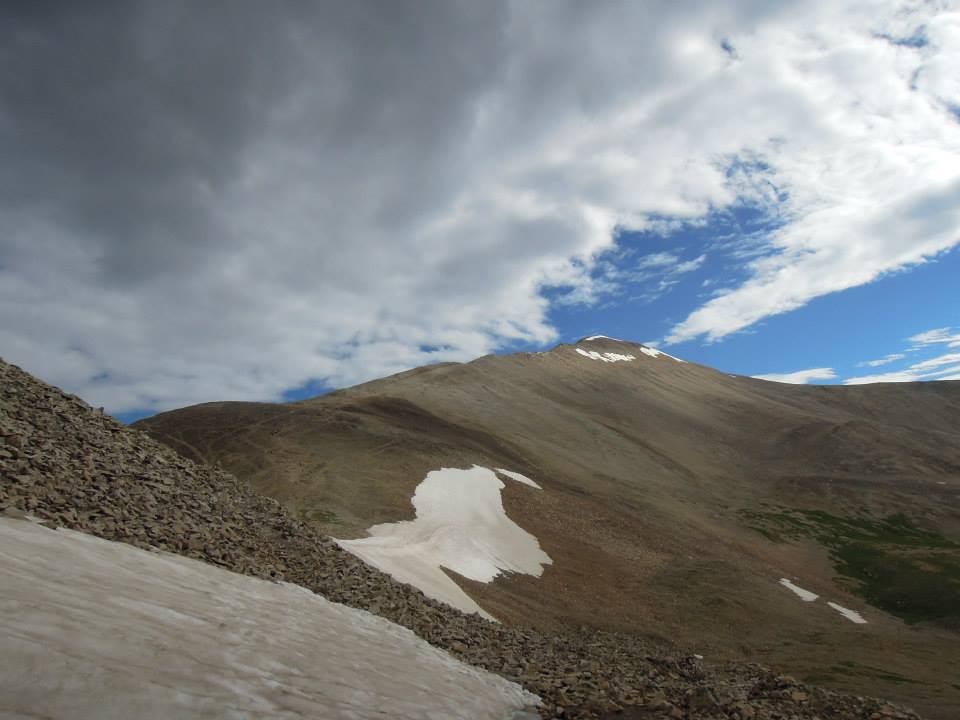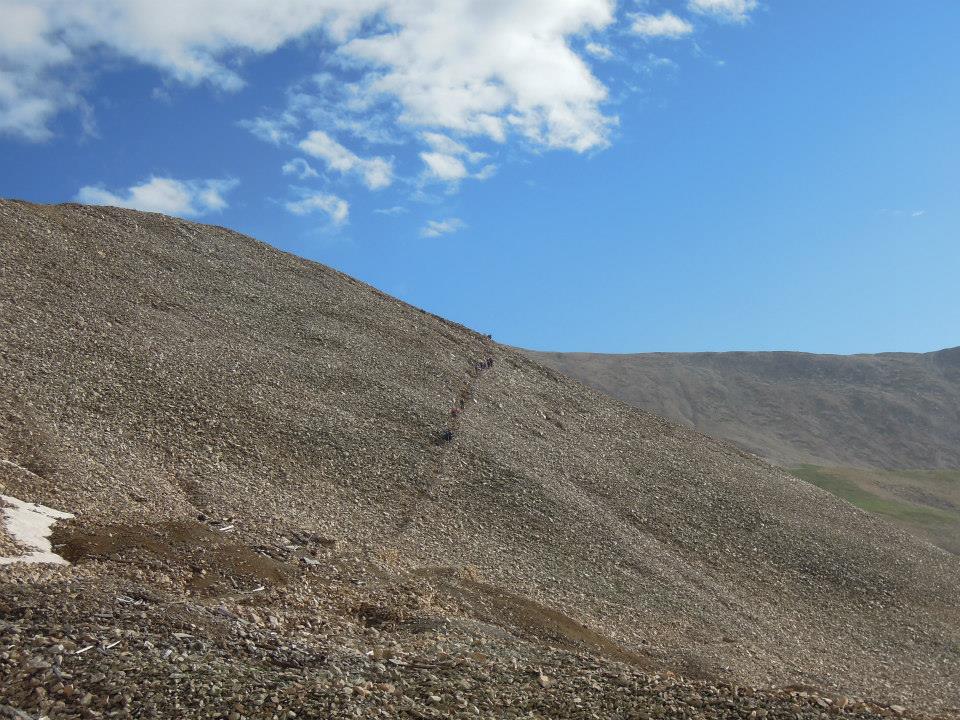
Late in the summer of 2013, I made it my quest to follow in my brother’s footsteps and conquer all of Colorado’s famous 58 14ers. On July 14, I made my first official documented trek up the Class 2 slopes of 14,035’ Mount Sherman with my brother and now sister-in-law. Our journey took us to southern Colorado into the 65 million year-old Mosquito Mountain Range. Although I had absolutely no idea what I would be facing, I was eager to spend the day hiking with my family. Upon arrival, a stunning pyramid of black rock and patches of eternal snow on the peak welcomed us. Sherman has no marked trailhead. Instead, hikers must use their best judgment to locate the base of the mountain. Scott, Kerry, and I parked our low-clearance vehicle along a rather steep and washed out dirt road approximately one mile from the start of the planned route. By the time that we had hiked to the Sherman base area I was already beginning to realize what I had gotten myself into and the real excitement had begun to sink in. We were surrounded by patches of grass with small, blue and purple flowers as well as less glorious muddy spots. About twenty minutes into our real ascent the grade became noticeably steeper; I cannot remember which I began to feel first – my unacclimated lungs or the burn in my calf muscles. After passing the remnants of a run-down mine, which had no doubt polluted all of the nearby streams, we came into a lush green valley. Unfortunately, my moment of awe did not last long. I looked up to see a new terrain challenge. Directly in front of us, the well-traveled dirt trail merged with a rather uninviting path that Scott referred to as the “Trail of Blood and Tears.”

The steep and treacherous “trail” was more like an intense incline made up of loose rocks and a lot less like a commonly traveled pathway. Nonetheless, with the occasional wobbly step and the need to catch myself with my hands, we made it to the top of the Trail of Blood and Tears. Now, about halfway to the summit, which hikers cannot even see until the final stretch of the ascent, I was ready to be finished. We continued onwards and upwards towards more rocky and winding trails until the first snow covered false summit finally came into sight. While Scott and Kerry talked amongst themselves I dealt with my rapidly emerging acute mountain sickness. I, being stupid, had not been drinking enough water throughout the trip. Ooops. To be completely honest, the last thirty minutes of our journey to the top was miserable; I was lightheaded, felt disgusting, and could not decide if I wanted to keep my jacket on or off. Kerry, so cute and comforting, assured me that if I were to pass out Scott would carry me back down. Despite her reassurance, I remained uneasy knowing that if I were to faint, I would plummet to my death. But, never fear, two more false summits later we found ourselves on top of Sherman and overlooking the entire Mosquito Range. It was absolutely breathtaking and I had successfully summited my first 14er.
After eating a small yet energizing lunch at the top, I felt much better and was ready to begin our descent journey back to the car. But, life is never that simple. With dark storm clouds quickly rolling in, we ran, literally ran, back down the southwest face of the mountain. About halfway down the heavy rainfall started. That was excellent. At this point, we were not even staying on the marked trails. Rather, in a dangerous attempt to race the lightning, we were summer glissading down lose rock and dirt. Once we finally reached the base we were mostly out of danger but soaking wet and now battling hail. I looked back once, silently saying goodbye to the mountain that I knew had just shaped my next few summers, and noticed a man who was still making his ascent of the summit. Not to be judgmental, but he was absolutely nuts; being above the tree line for over half of the climb makes you the perfect target for lightning strikes.
We continued our run down the muddy road, giving the evil eye to every passing pick-up truck that did not offer us a ride to our vehicle, until we finally reached the dry sanctuary of Scott’s car. Freezing and exhausted, I was ready to go home. Including the times we briefly stopped so that I could catch my breath and our lunch break on the summit, it took our small group approximately four hours round-trip to conquer Sherman; although Scott, who was actually acclimated could have made the ascent at a more rapid pace. Thinking back, I was reasonably fit at the time of the climb but now I know how hard I need to push myself in the off season to be sufficiently prepared for the rest of Colorado’s castles. There is no doubt that climbing a 14er requires more planning than a weekend camping trip, more endurance than a 10k run, and more perseverance than boot camp. Nonetheless, hiking in Breckenridge is always a blast!
…and thus began my love for mountaineering.

©Jenna Lowery
Directions from Breckenridge: Follow CO-9 south to Fairlplay. Drive just over one mile south on US 285 and turn right onto CR 18. Proceed to drive 10 miles to a large parking area (the Leavick site). The road starts to get rough after this point but passenger cars can make it another 1.5 miles before the road becomes too harsh for driving. There are a couple of small pull-off areas along the way.

Hey very interesting blog!